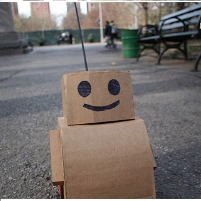Humans Help Robots on City Streets
Thursday, May 21, 2009
 Tweenbot
Tweenbot
Perhaps the future for human-robot coexistence is a lot friendlier than portrayals like I, Robot. Kacie Kinzer, a graduate student at NYU’s Tisch School of the Arts, conducted an experiment with small, disposable robots to see if New Yorkers would help guide the lost little machines. Kinzer built her 10-inch Tweenbots out of cardboard and simple motorized chassis because she assumed they would be destroyed by careless pedestrians or stolen. Instead, people stopped in their tracks to assist the Tweenbots, which carried a small flag telling where they were headed. Some people redirected the robots when it was apparent they were going in the wrong direction, or helped them get free of obstacles, like park benches or potholes.
A similar experiment was carried out on the streets of Munich, Germany, where the Autonomous City Explorer, or ACE, was set loose to see if Germans would help guide the robot. Roughly the size of a human, ACE was equipped with cameras and a voice simulator that could ask people for assistance. And help they did, offering verbal and hand signal directions that the robot followed to reach its destination.
What the experiments demonstrated, writes Aaron Saenz at Singularity Hub, is that “robot-human interaction could be successful.” He supposes that perhaps the reason why people were so willing to help Tweenbot and ACE is the shared human fear of being lost and not finding our way home. “We will accept artificial life by seeing it as a reflection of ourselves,” he says.
-Noel Brinkerhoff
The Lost Robot Saga Continues: Munich (by Aaron Saenz, Singularity Hub)
Tweenbots - Depending on the Kindness of Strangers (by Aaron Saenz, Singularity Hub)
Tweenbots (by Kacie Kinzar)
- Top Stories
- Unusual News
- Where is the Money Going?
- Controversies
- U.S. and the World
- Appointments and Resignations
- Latest News
- Musk and Trump Fire Members of Congress
- Trump Calls for Violent Street Demonstrations Against Himself
- Trump Changes Name of Republican Party
- The 2024 Election By the Numbers
- Bashar al-Assad—The Fall of a Rabid AntiSemite






Comments